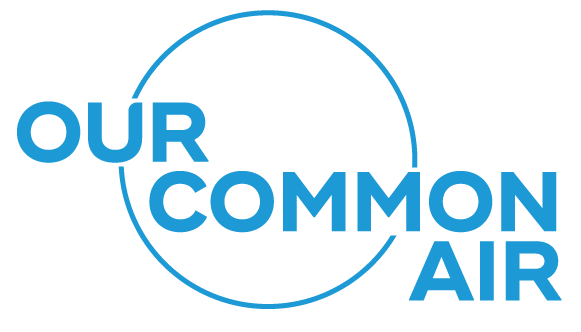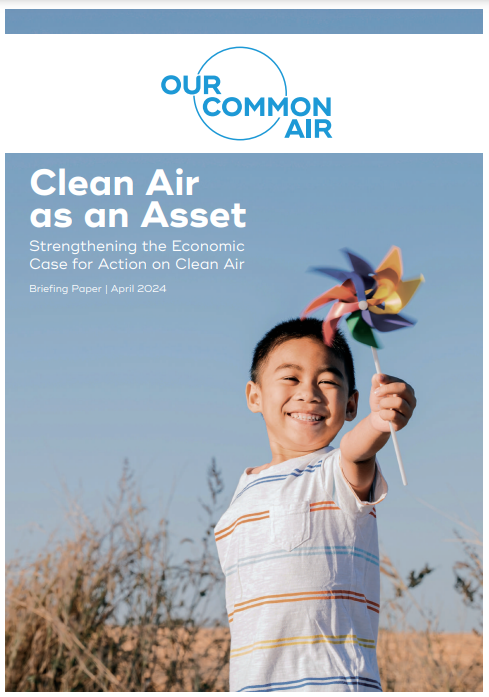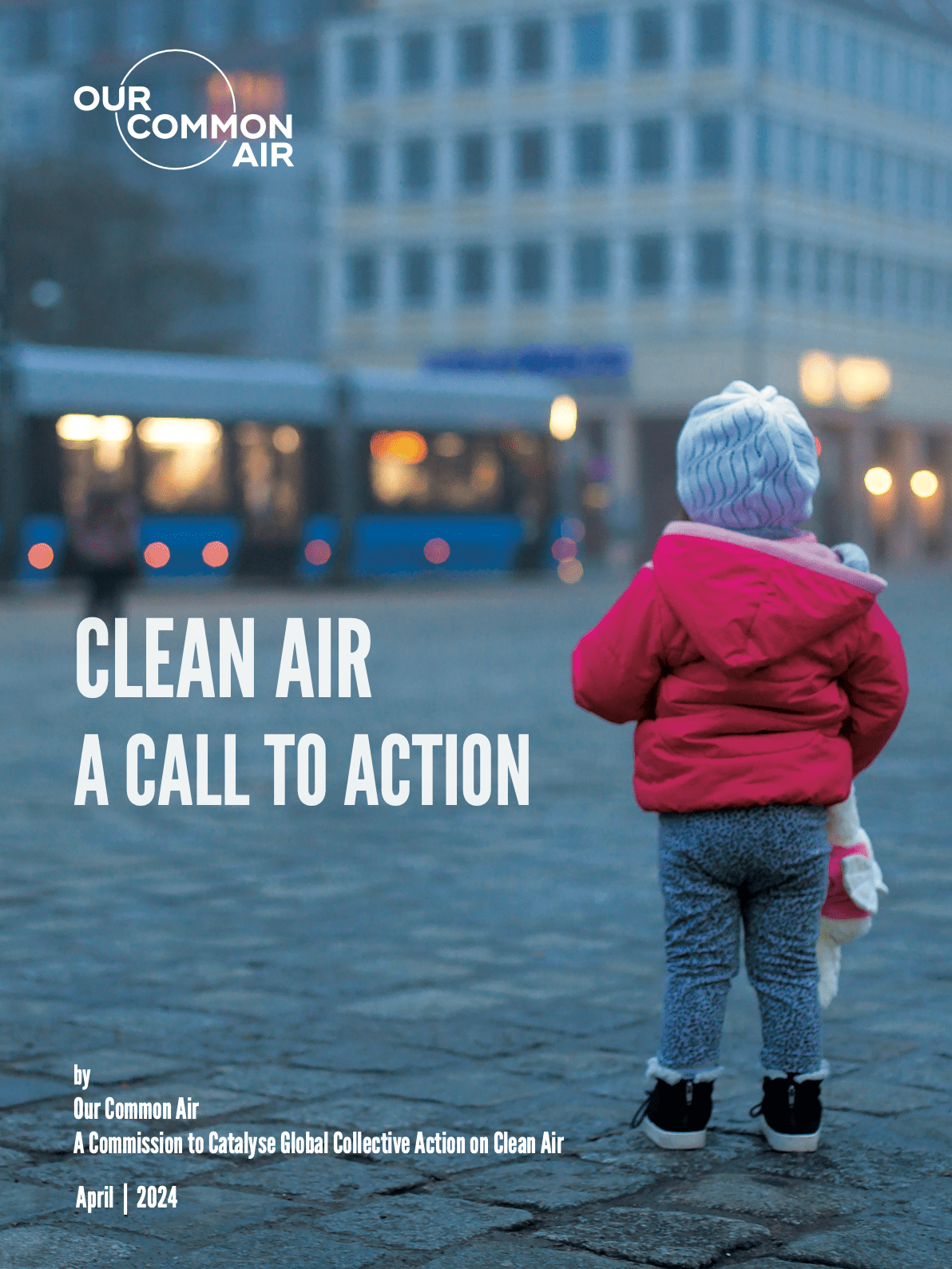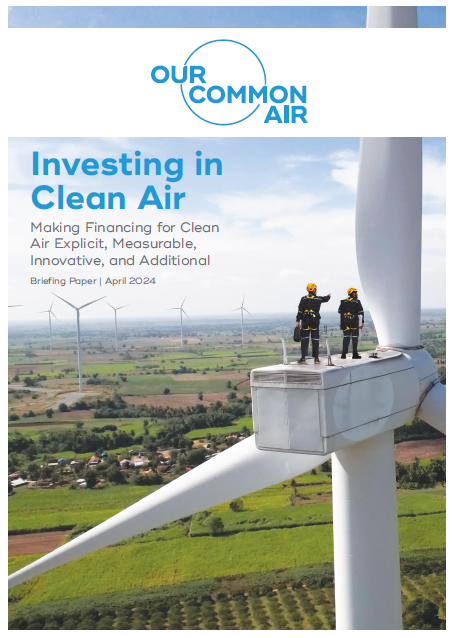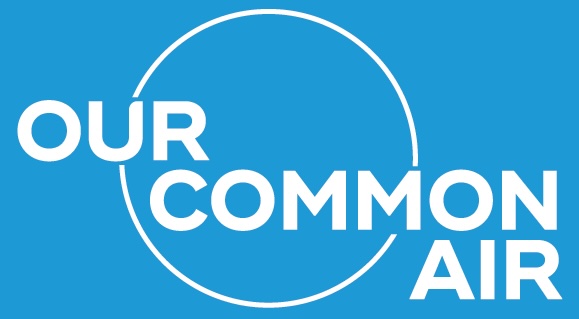
Clean Air as an Asset
Strengthening the Economic Case for Action on Clean Air
A Briefing Paper from Our Common Air
A stronger case needs to be made that cost-effective opportunities to cut polluting emissions are available and must be accelerated at scale to advance public health and well-being.
April 2024
Authors: Our Common Air
Suggested citation: Our Common Air Commission (2024). Clean Air as an Asset: Strengthening the Economic Case for Action on Clean Air. Available at https://www.ourcommonair.org/clean-air-as-an-asset/
Executive summary
The costs of air pollution are significant. The World Bank estimates the health damages caused by air pollution amount to USD 8.1 trillion a year, or 6.1% of global GDP.1 Meanwhile, according to OECD, the annual number of lost working days as a result of outdoor air pollution is projected to reach 3.7 billion by 2060 (currently around 1.2 billion).2 This in turn affects productivity.
Although alarming estimates like these exist, the full economic case for investing in clean air is not being made convincingly or consistently enough to finance ministries and development funders. The result is significant underinvestment in tackling air pollution.
A stronger case needs to be made that cost-effective opportunities to cut polluting emissions are available and must be accelerated at scale to advance public health and well-being. The clean air benefits of the energy transition are a major part of this business case — especially as they almost all accrue locally, whereas the health and economic benefits are more distributed.
Furthermore all countries, especially low and middle-income countries, have numerous competing demands on scarce resources. So funding is unlikely to be made available if the benefits are only perceived to be environmental.
In 2021, international development funding for outdoor air quality projects exceeded funding for fossil fuel-prolonging projects for the first time.3 This is positive, but we need to ensure this momentum translates into clear strategies for phasing out fossil fuels and transitioning to cleaner energy fairly and equitably, which in turn will unlock economic, social and health benefits.
Existing studies on the economic impact of air pollution provide a strong foundation on which to build. However, the analyses under-represent the case, are not relevant to every geography, and do not couple benefits and cost of action to allow for comparison. A more robust and comprehensive economic analysis is needed, which is specific enough about which opportunities should be acted upon, when and by whom.
There are also challenges in the current framing, which means the information is not as compelling as it could be. For example, talking about air pollution as a huge, global problem can make it seem insurmountable. Furthermore, the most frequently cited statistics are not relatable or memorable enough for ministers or for the general public.
The framing should centre clean air as an asset, and a potential driver of net economic growth, as well as of measurable and relatable improvements to individual wellbeing and health. To make the numbers meaningful and memorable, they should be compared to other global issues or distilled down to the benefit per individual or family.
The addition of human stories would also make the numbers more relatable, getting traction not just with finance ministries and development funders but with the people they serve. There is a huge opportunity to drive measurable gains for people and nature, from the local to the global level, by investing in clean air.
To realise the opportunity, we need to get better at quantifying and describing the potential gains, so we can work towards them together.
Why we need a strengthened economic case
When the economic case for action on any issue is made well, it pushes the issue forward. It gives a clear rationale for action by economic and finance ministers and development finance institutions.
In turn, attention by finance ministries can elevate an issue from something that matters for the environment or health, to something that is critical for the whole economy. It can also result in more support for regional or local initiatives, driven by mayors or city administrators.
There are some useful precursors where environmental and health initiatives have got traction with finance ministries because of effective framing, and a clear economic case being made. For example, The Global Commission on the Economics of Water proposed treating the global water cycle as a global common good via a mission-driven approach, proper pricing, phasing out inefficient subsidies, and investments via joint partnerships.4 This approach was formally recognised at the UN Conference on Water in March 2023 and in the G20 New Delhi Leaders’ Declaration in September 2023.
Similarly, the Commission on the Economic Risks of Climate Change in the United States, led by Mike Bloomberg, Hank Paulson, and Tom Steyer, detailed how damages from storms, flooding, and heat waves were already costing local economies billions of dollars. It described local impacts specific to US regions and the difference the average American would likely see in weather events from their childhood to later life phases, making it relatable on an individual level.5
Meanwhile, the high economic burden of HIV AIDS, particularly in Sub-Saharan Africa, was one of the key observations made in the Declaration of Commitment on HIV AIDS at the United Nations General Assembly Special Session in June 2021.6
Air pollution is a problem that affects almost everyone on the planet. The World Health Organisation estimates that 99% of the global population is breathing air that exceeds its official air quality guidelines all, and that this results in more than 7 million premature deaths a year.7,8 Improving air quality would reduce asthma, heart attacks, stroke, and even mental illness, with the benefits accruing to the most to vulnerable groups.
And yet, The State of Global Air Quality Funding 2023 found that less than 1% of international development funding and 2% of international public climate finance (USD 1.66 billion per year) has been committed to targeting air pollution over the last six years.9 Funding for outdoor air quality projects (USD 2.3 billion) exceeded funding for fossil fuel-prolonging projects (USD 1.5 billion) for the first time in 2021.10 This is positive, but we need to ensure this momentum translates into clear strategies for phasing out fossil fuels and transitioning to cleaner energy fairly and equitably.
Ultimately, not enough is being done at any level – from the local to the global – to tackle the pervasive and wide-reaching problem of air pollution or to unlock the many potential co-benefits of action. This paper argues that part of the reason for that is that a strong economic case has not yet been made clearly or consistently enough. Below we set out how to close the gap.
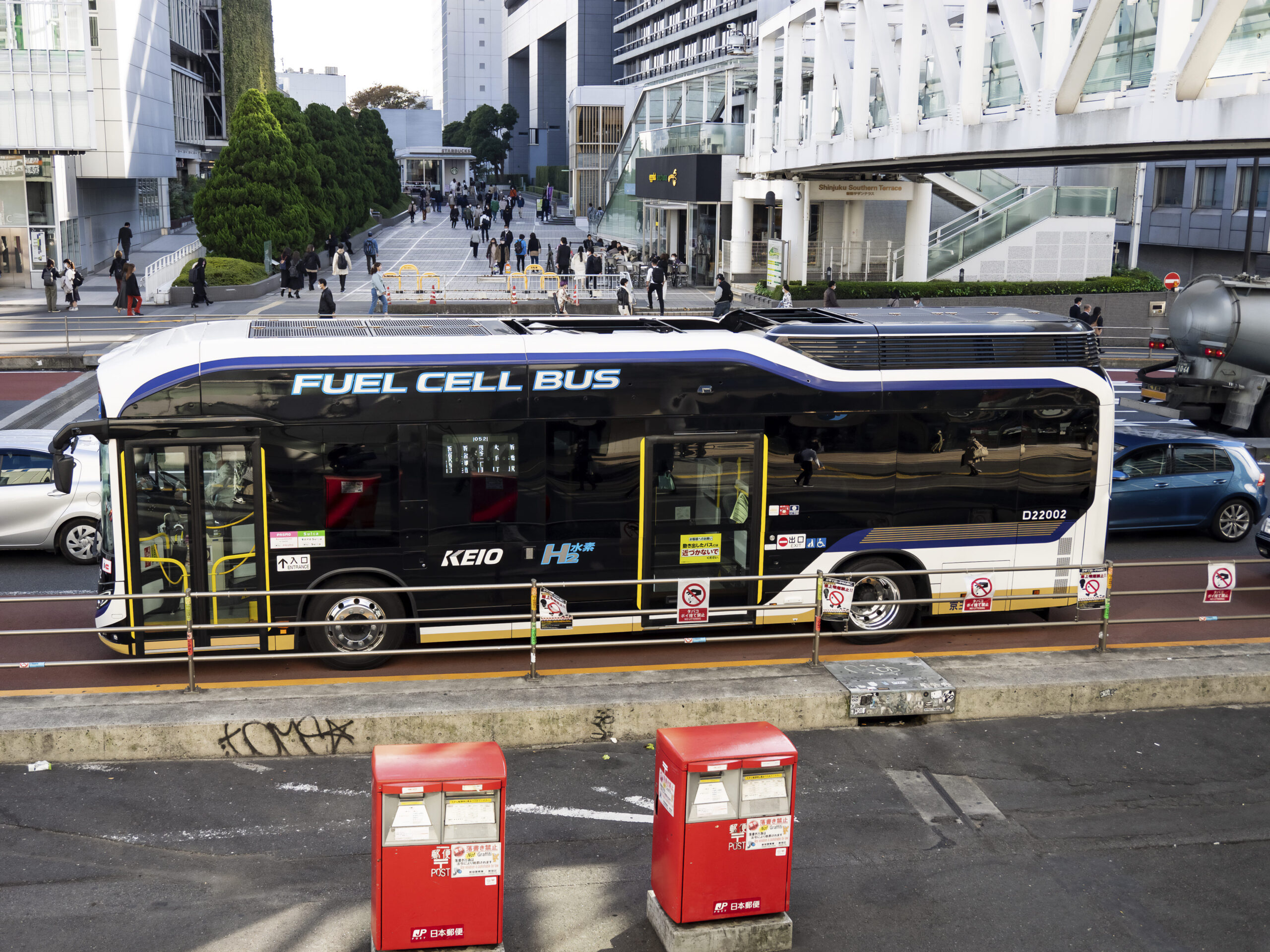
Image: iStock
Assessing the current evidence base
There are many studies that either quantify the costs of air pollution or demonstrate how reducing air pollution could drive economic benefits. They are often in peer-reviewed papers and presented by credible messengers, such as the US government, the European Commission, the World Bank, the OECD, the Confederation of British Industry, and the Confederation of Indian Industry.
Notably, in an assessment of the costs and benefits of the Clean Air Act, the United States Environmental Protection Agency found that every USD 1 spent on air pollution control yielded an estimated USD 30 in economic benefits.11 Similarly, the European Commission’s impact assessment for its revised Ambient Air Quality Directives predicts that the improvement in air quality around Europe, will result in gross annual benefits of between €42 and €121 billion by 2030, while costing less than €6 billion a year.12
Other studies set out more specific costs and potential benefits for health, the economy, education, tourism, food and energy, and business. We describe some of these below.
1. Health costs and potential benefits
According to the World Bank, the health damages caused by air pollution amount to USD 8.1 trillion a year, equivalent to 6.1% of global Gross Domestic Product (GDP).13 Savings from action to address this would accrue to public and private health providers, families and individuals.
For example, a study looking at outpatient care for respiratory diseases from universal health insurance claim data in Taiwan during 2006–2012 found that each one-unit reduction in the air quality index led to savings of nearly USD 74 million a year in respiratory-related outpatient expenditure.14
London’s efforts to decrease air pollution resulted in reductions in childhood asthma hospital admissions by 30% from the period 2014–2016 to the period 2017–2019.15
2. Business costs and potential benefits
The OECD estimates that approximately 1.2 billion workdays are lost globally each year due to air pollution, and this could reach 3.8 billion days by 2060 without preventative action.16
A recent study of BRICS economies found a statistically significant, negative impact of air pollution on corporate investment.17 The study suggests this is driven by factors that include worker health and productivity, investor attitudes, and the cost of environmental regulations.
The negative impact of air pollution on foreign investments has also been demonstrated. For example, in China, researchers found that for every 1% increase in PM2.5 concentration, foreign direct investment flows decrease by 0.393%, and foreign direct investment stocks decrease by 0.015%.18
Conversely, by investing in air pollution control technology, China has established itself as the largest emerging market in the world for environmental technology products, with an average compound annual growth rate (CAGR) of 14.1%19 from 2016 to 2020, compared to the global market CAGR of ~5%.20 China’s environmental protection industry accounts for 1.9% of China’s GDP and employs more than 3.2 million people.21
Similarly, the US Clean Air Act spurred technology investments by companies to reduce pollution and created jobs in engineering, manufacturing, construction, materials, operation, and maintenance.22 In 2018, the US environment protection and services industry generated approximately USD 345 billion in revenues and exported goods and services worth USD 47.8 billion.23 The industry supported 1.6 million jobs.
Globally, the air pollution control systems market was valued at USD 66.54 billion in 2017 and is expected to grow at a CAGR of 5% by 2025.24 Given this demand may largely be driven by emerging economies, there is also a strong case for indigenisation and domestic manufacturing of technology.
3. Food and energy costs and potential benefits
There is ample evidence of the negative impact of ambient air pollution on crop productivity. According to United Nations Economic Commission for Europe, current levels of air pollution (primarily ozone) reduce global yields by 7-12% for wheat, 6-16% for soybean, and 3-4% for rice and maize, causing economic losses of up to USD 26 billion per year.25
Meanwhile, haze, smog, and other pollutants that affect the intensity and quality of sunlight can reduce the reliability and performance of solar installations. A global study estimated that aerosols over extremely polluted areas might reduce solar power generation by more than 50%.26
Evidence from eastern China suggests that particulate matter pollution reduced solar photovoltaic productivity by 20%.27 Evidence from India suggests that air pollution cut India’s solar energy output by 29% and that cleaner air could increase India’s solar energy output by 6-28 TWh.28
4. Education costs and potential benefits
Exposure to high levels of air pollution can negatively impact children’s learning outcomes by affecting brain development, worsening respiratory illnesses, and causing absenteeism (days of school not attended), fatigue, and attention problems.29,30
Evidence from rural India shows that air pollution significantly reduces reading and mathematics outcomes for children aged 5–16 years, with these effects being more pronounced in girls and older children.31
A study that assessed academic performance data (high school national exam) from 25,390 high schools in Brazil found that an increase of 10 μg/m3 in the long-term average PM2.5 around the Brazilian schools was associated with ~3 points lower in the school-level academic performance.32
Evidence from Israel found that PM2.5 exposure during matriculation exams significantly reduced student performance, and for these test-takers, PM2.5 exposure also negatively impacted post-secondary educational attainment and earnings.33

Image: iStock
5. Tourism costs and potential benefits
Clean air enhances the attractiveness of destinations for tourism and recreational activities, as well as promoting the growth of the recreation and leisure industry.
A study from China that looked at evidence from 58 major cities found that a 1% increase in the air quality index led to a 1.25% reduction in tourist footfall.34 Evidence from India suggests that air pollution causes an annual 0.7% reduction in tourist arrivals and USD 1.7 billion in economic loss.35
These studies demonstrate the scale of the problem – and the potential benefits of action, which are far higher than many other environmental challenges that have received global attention. For example, ocean plastic pollution is estimated to have an economic impact of up to USD 2.5 trillion per – much less than air pollution.36
There are also other papers in the pipeline, including the Climate and Clean Air Coalition (CCAC) integrated assessment of the economic impacts of air pollution and climate.37
6. What’s missing from the evidence so far?

Image: Anna Liminowicz/Climate Visuals
However, despite the varied evidence and examples, these studies do not add up to a comprehensive, compelling, or consistent case for action on clean air.
Many of them quantify the costs, but do not estimate the potential benefits. They are either too specific to one geography, or too global to be applicable locally. The methodologies are not comparable, and the examples used are often not relatable to individual voters or policy makers. There are gaps in the evidence, and the framing does not appeal strongly enough to the target audiences.
As a result, the case for clean air action is not yet influencing finance and economic development ministries or other development funders to support air pollution abatement and allocate resources for new interventions or bolster regulatory enforcement.
We believe that a regular, more comprehensive economic case that looks at the costs of interventions as well as the benefits of action is a necessary (but not sufficient) condition for greater action on air pollution. Work to produce such a case would also help identify data gaps to be filled.
We set out what this case could look like in the next section.
Strengthening the economic case for action
There are several ways the case for action on clean air could be strengthened. The key ones are:
1. Make it geographically relevant
Existing studies are not relevant to every geography. Very few studies are both comprehensive and sufficiently specific to regions, countries, or cities. Often the macro numbers are hard for national and city policymakers to translate into action. Too often, the numbers are out of date.
To be useful, analysis needs to be applicable to local circumstances, where ‘local’ could mean a city, an airshed region, or a national-level intervention.38 City-level analyses are useful for choosing projects and making investment decisions, while regional analyses are helpful for countries to compare with other regions on a like-for-like basis, for instance, in terms of economic competitiveness. A national-level analysis is often the scale at which finance ministers will be convinced.
2. Measure costs as well as benefits
The benefits most studies estimate are often not set against the projected cost of taking action (financial cost and also ease of implementation). When direct costs to the economy are considered, these are usually focused on specific sectors and often at a subnational level. Methodologies and time scales vary, making it harder to do spatial and temporal comparisons.
Costs should be estimated at the macroeconomic level too, such as how much would it cost to meet WHO guidelines globally versus the costs of a graded set of actions for a particular country.
For the private sector, estimates of costs, as well as investment opportunities for specific sectors (energy, transport, construction, pollution abatement equipment, etc.), are needed to trigger sector-wide actions and reduce concerns about individual companies losing out from a unlevel-playing field.
3. Make it comprehensive
There is insufficient research on the impacts of air pollution on education, housing, energy generation, the liveability of cities, and biodiversity.39
As a result, potential economic benefits of action on clean air are frequently not counted in impact analyses. These include benefits to education attainment and future earnings, the opportunity catalysed by air pollution monitoring and abatement technologies, and the gains for particular sectors including solar energy and tourism.

Image: iStock
4. Make it regular
The economic case for action on clean air is not made with enough regularity. There is no regular ‘drumbeat’ to serve as a constant reminder of this hidden opportunity for economic development.
A single report is rarely enough to trigger action; regular assessments would have a better chance of ensuring that pollution abatement targets are set and progressively met year-on-year. This is increasingly evident now in regulatory approaches that demand assessments and reporting of climate-related business risks. A regular assessment would:
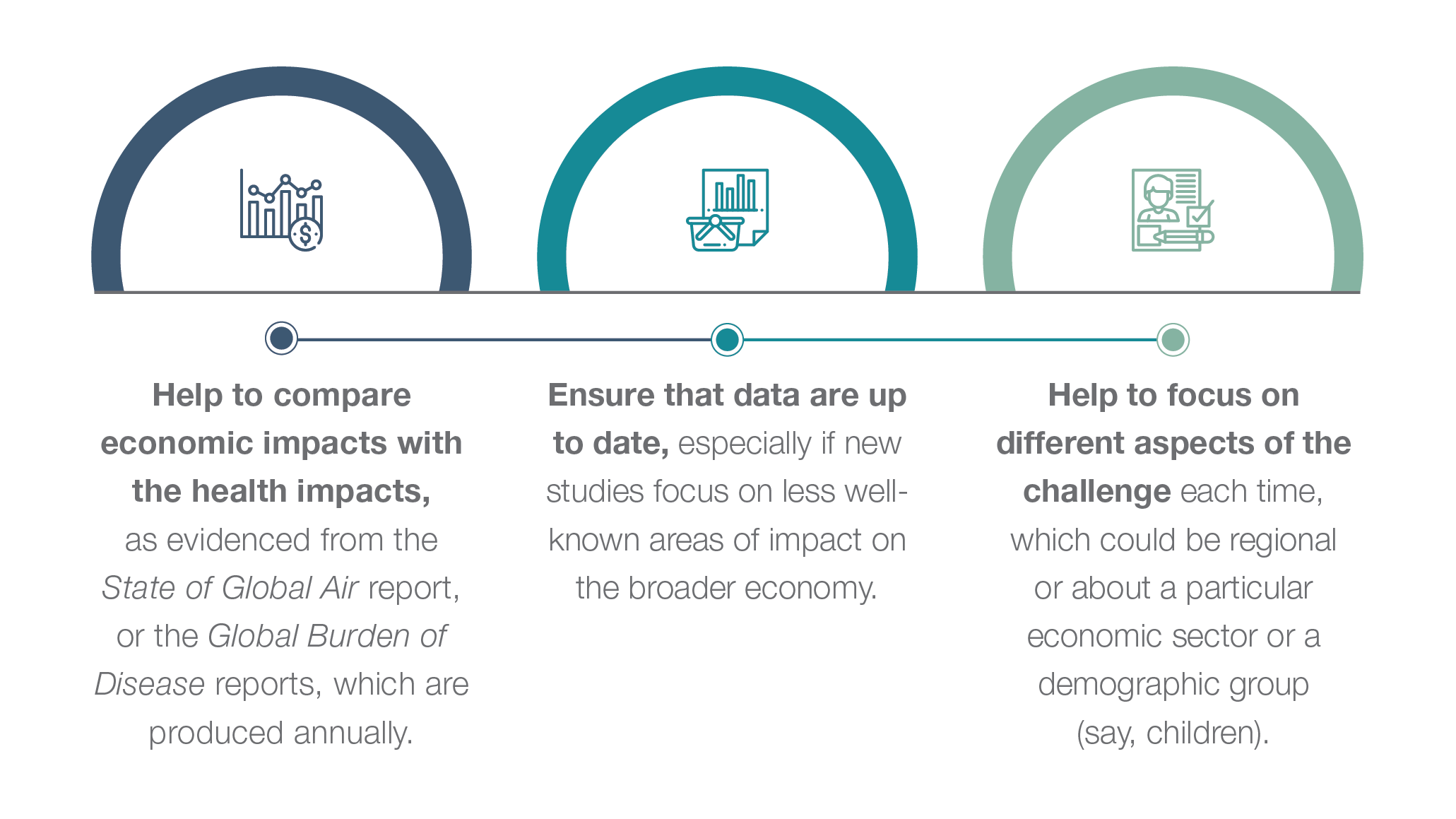
5. Make it personal and relevant to target audiences
While the aggregate economic impacts of air pollution are enormous and global, describing them like this can make it difficult to relate to an individual’s experience. This framing is, therefore, not memorable to ministers or to the general public.
It’s key to combine analytical rigour with human stories. The popular case for clean air — attracting voters and constituent support — is important. If citizens are convinced, then politicians will be convinced. For this, there is a need to demonstrate to different stakeholders the benefits of clean air for their own lives and livelihoods.
Framing the economic impacts per family or individual can be a powerful way for ministries, businesses, politicians, and others to make the economic case for clean air. Evidence that this approach works is the media and political attention given to the Air Quality Life Index, which talks about the impact of air pollution in terms of an average individual.40
In addition to statistics that bring the economic benefits down to an individual level, case stories of specific people are more memorable and relatable. An example of a health case that has attracted significant international attention is that of Ella Adoo-Kissi-Debrah, the first person in the world to have air pollution written as the cause of death on her death certificate. Finding similar stories for the livelihood impact would be very compelling.
There is also potential to calculate the impact on specific groups or industries to catalyse further action. For example, a study on Chinese household purchases of insurance found that air pollution significantly increased the probability of insurance purchases by households as well as the expenditure on insurance premiums.41
6. Make it achievable and investable
A strengthened economic case for action on air pollution would present clean air as achievable and an asset in which it makes sense to invest. The 1993 World Development Report, Investing in Health, argued that better health could be had for rather modest additional sums per capita per year.42 It successfully influenced structural adjustment policies and health sector reforms in many developing countries. The same opportunity exists now on clean air.
One way of doing this is expressing benefits in terms of incremental progress: for example, USDs per microgram of PM2.5 abated, or benefits accrued once a WHO interim target is met. Presenting achievable, ‘bite-sized’ reductions can help create political and social will.
7. Spell out the lessons for others
Showcasing policy success stories at the level of specificity required for replication is also important. National and city governments want to understand what actions were taken, what the financial and political costs were, and what benefits accrued to persuade them to replicate.
Decades ago, California started focusing on air quality, especially in the Los Angeles area. As a result, vehicle-related air pollutants have decreased by about 98%.43 More recently, China’s efforts at air pollution abatement have ensured that in Hebei, once the most polluted region of the country, PM2.5 concentrations have reduced by 40% between 2012 and 2017.44
In London, specific policies such as the Ultra-Low Emissions Zone (ULEZ) have reduced air pollution and greenhouse gases at the same time. In the four years from its implementation in 2019 to February 2023, ULEZ reduced NOx emissions by 23%, PM2.5 emissions by 7%, and CO2 emissions by 3%.45
Sharing the details about how such successes were achieved, as well as what did not work, would be valuable. Countries, cities, and regions will be more convinced when they see the consequences of actions taken elsewhere. There would also be value in standardising the methodologies used in impact analyses to ensure they are comparable.
8. Quantify the gains in a way that works for policymakers
For policymakers and investors who allocate resources to competing priorities, it is not sufficient to qualitatively assert the inherent desirability of clean air (such as better health and longer life expectancy) or its expected positive effect on GDP growth.
It is more robust to use full-income GDP, which combines both annual income and the number of years over which that income is enjoyed. In essence, full-income approaches impute the value of increased life expectancy on economic well-being using revealed[1]preference approaches to value each year of longer life.46,47
Within that rubric, one approach to evaluating and informing the case for investing in clear air is the use of ‘value of a statistical life’ (VSL), which is arguably the most important number in benefit-cost analyses of environmental, health, and transportation policies.48
VSL is widely used in economics and regulation to denote not the value placed on a particular life but the public health measures that can reduce the statistically expected number of deaths by one.49 VSL would then enable the estimation of the benefit-cost ratio of investing in clean air, and that ratio informs the comparison of options available to investors.
It must be noted that this approach holds promise only to the extent that resource allocation decisions include a rational consideration of such evidence. The approach is more policy-robust than the cost per Disability-Adjusted Life Year (DALY) averted, which is common among health analysts, but lacks the fundamental attributes of (i) widespread use across sectors and (ii) expression in a commonly understood measure such as the benefit-cost ratio, which the VSL enables.
Conclusion and recommendations
There are undoubtedly huge potential benefits of action to clean the air but we need to get better at quantifying and describing them. We recommend the following actions for different stakeholders to help make the economic case for clean air better and, in doing so, drive investments.
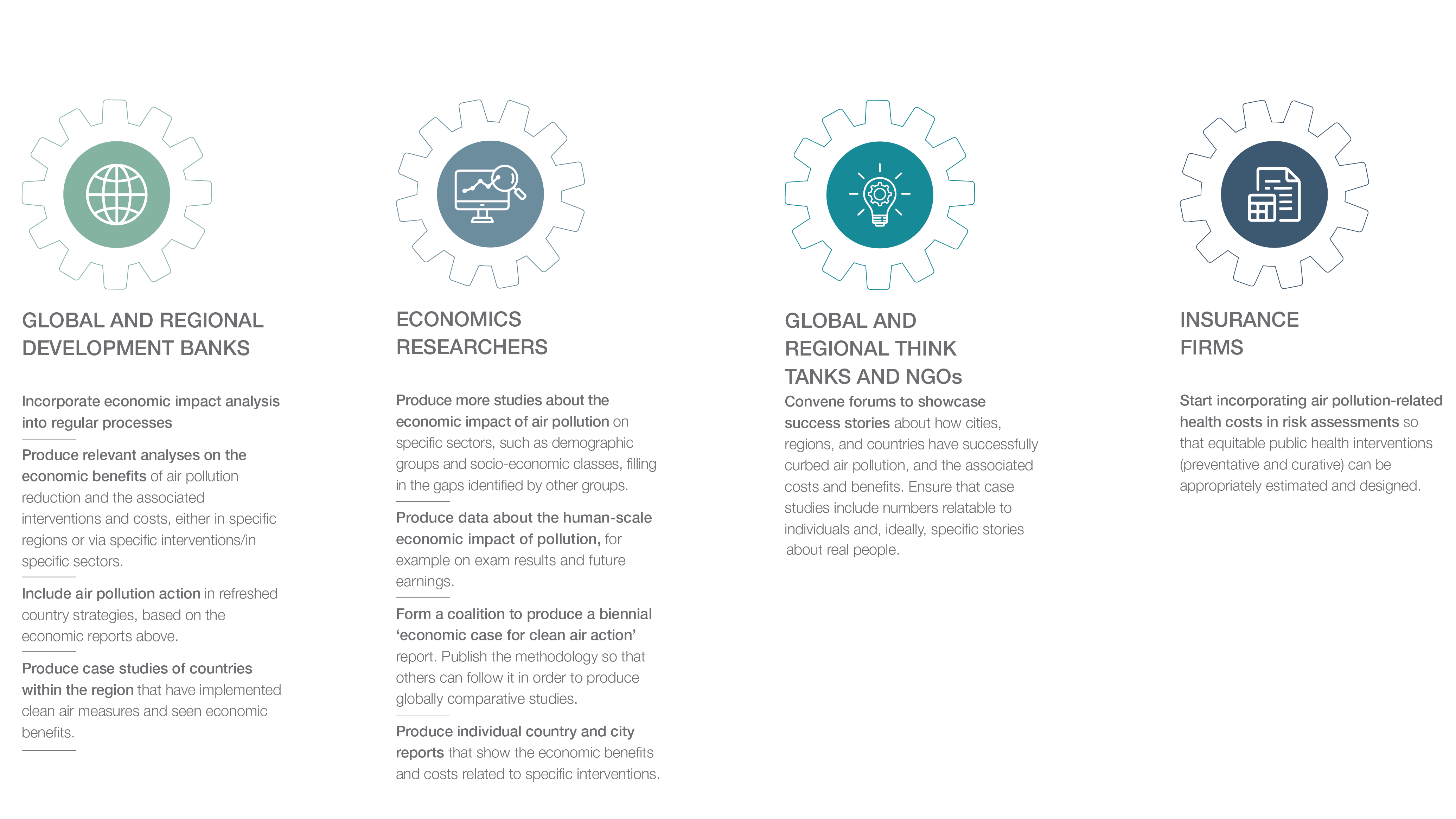
Endnotes
1 World Bank. 2022. The Global Health Cost of PM2.5 Air Pollution: A Case for Action Beyond 2021. International Development in Focus. Washington, DC: World Bank. https://openknowledge.worldbank.org/entities/publication/c96ee144-4a4b-5164-ad79- 74c051179eee
2 Organisation for Economic Co-operation and Development (OECD). 2016. The Economic Consequences of Outdoor Air Pollution. Paris: OECD Publishing. https://www.oecd.org/environment/indicators-modelling-outlooks/Policy-Highlights-Economic-consequences-of-outdoor-air-pollution-web.pdf
3Strinati, Costanza, Sean Stout, Jake Connolly, Léa Faucheux and George Tsitati. 2023. The State of Global Air Quality Funding 2023. Clean Air Fund. https://www.climatepolicyinitiative.org/publication/the-state-of-global-air-quality-funding-2023/
4 Global Commission on the Economics of Water. 2023. Turning the Tide: A Call to Collective Action. Paris: OECD Environment Directorate Climate. https://watercommission.org/ wp-content/uploads/2023/03/Turning-the-Tide-Report-Web.pdf
5 Risky Business. 2014. The Economic Risks of Climate Change for the United States. Risky Business. https://riskybusiness.org/site/assets/uploads/2015/09/RiskyBusiness_Report_WEB_09_08_14.pdf
6 UNAIDS. 2001. Keeping the Promise: Summary of the Declaration of Commitment on HIV/AIDS. https://www.unaids.org/sites/de-fault/files/sub_landing/files/jc668-keepingpromise_en.pdf
7 World Health Organisation (WHO). 2022. “Billions of people still breathe unhealthy air.” 4 April, 2022. https://www.who.int/news/ item/04-04-2022-billions-of-people-still-breathe-unhealthy-air-new-who-data
8 World Health Organisation (WHO). 2022. “Ambient (outdoor) air pollution.” 19 December, 2022. https://www.who.int/news-room/fact[1]sheets/detail/ambient-(outdoor)-air-quality-and-health
9 Strinati, Costanza, Sean Stout, Jake Connolly, et al. 2023. The State of Global Air Quality 2023. Clean Air Fund. https://www.cleanairfund. org/resource/state-of-global-air-quality-funding-2023/
10 ibid.
11 US Environmental Protection Agency. 2011. The Benefits and Costs of the Clean Air Act from 1990 to 2020. https://www.epa.gov/
sites/production/ files/2015-07/documents/fullreport_rev_a.pdf
12 European Commission. 2022. “Proposal for a Directive of the European Parliament and of The Council on Ambient Air Quality and Cleaner Air for Europe.” https://eur-lex.europa.eu/legal-content/EN/TXT/HTML/?uri=CELEX:52022PC0542
13 World Bank. 2022. “What You Need to Know About Climate Change and Air Pollution.” Last modified 1 September 2022. https://www.worldbank.org/en/news/feature/2022/09/01/what-you-need-to-know-about-climate-change-and-air-pollution
14 Liu, Ya-Ming, and Chon-Kit Ao. 2021. “Effect of Air Pollution on Health Care Expenditure: Evidence from Respiratory Diseases.” Health Economics 30: 858–75. https://doi.org/10.2139/ssrn.3909701
15 Environmental Research Group. 2022. Health Impact Assessment of Air Pollution on Asthma in London. London: Imperial College London. https://www.london.gov.uk/programmes-and-strategies/environment-and-climate-change/environment-publications/health-
im-pact-assessment-air-pollution-asthma-london-0
16 OECD. 2016. The Economic Consequences of Outdoor Air Pollution. Paris: OECD Publishing. https://doi.rg/10.1787/9789264257474-en
17 Farooq, Umar, et al. 2023. “Impact of Air Pollution on Corporate Investment: New Empirical Evidence from BRICS.” Borsa Istanbul
Review 23, no. 4 (July): 876–86. https://doi.org/10.1016/j.bir.2023.03.004
18 Li, Weibing, and Kaixia Zhang. 2019. “Does Air Pollution Crowd Out Foreign Direct Investment Inflows? Evidence from a Quasi-natural Experiment in China.” Environmental & Resource Economics, 73(4): 1387-1414. https://ideas.repec.org/a/kap/enreec/v73y-
2019i4d10.1007_s10640-019-00329-8.html
19 International Trade Administration, USA. 2023. “Environmental Technology.” China: Country Commercial Guide. https://www.trade.
gov/country-commercial-guides/china-environmental-technology
20 Grand View Research. n.d. Environmental Technology Market Size, Share and Trends Analysis Report by Component, by Application, by Technological Solutions (Greentech/Renewable Energy, Carbon Capture), by Vertical, by Region, and Segment Forecasts, 2023–2030. https://www.grandviewresearch.com/industry-analysis/environmental-technology-market-report#:~:tex-t=Report%20
Overview,5.3%25%20from%202023%20to%202030
21 International Trade Administration, USA. 2023. “Environmental Technology.” China: Country Commercial Guide. https://www.trade.gov/country-commercial-guides/china-environmental-technology
22 US Environmental Protection Agency. n.d. “The Clean Air Act and the Economy.” Clean Air Act Overview. https://www.epa.gov/clean-air-act-overview/clean-air-act-and-economy#invest
23 International Trade Administration, USA. 2020. 2019 Top Markets Report Environmental Technologies: A Market Assessment Tool for
US Exporters. https://www.trade.gov/sites/default/files/202005/2019%20Environmental%20Technologies%20Top%20Markets%20Report.pdf
24 Grand View Research. n.d. Air Pollution Control Systems Market Size, Share and Trends Analysis Report by Product (Scrubbers,
Catalytic Converters, Thermal Oxidizers, Electrostatic Precipitators), by Application, and Segment Forecasts, 2020–2025. https://www.grandviewresearch.com/industry-analysis/air-pollution-control-systems-market
25 United Nations Economic Commission for Europe (UNECE). 2022. “New Research Confirms Multi-Billion Dollar Impact of Air Pollution on Natural Vegetation and Crops.” Last modified February 28, 2022. https://unece.org/climate-change/press/new-research-con-firms-multi-billion-dollar-impact-air-pollution-natural.
26 Li, Xiaoyuan, Denise L. Mauzerall, and Mike H. Bergin. 2020. “Global Reduction of Solar Power Generation Efficiency Due to Aerosols
and Panel Soiling.” Nature Sustainability 3 (June): 720–27. https://www.nature.com/articles/s41893-020-0553-2
27 Li, Xiaoyuan, et al. 2017. “Reduction of Solar Photovoltaic Resources Due to Air Pollution in China.” Proceedings of the National Acad-
emy of Sciences 114 (45): 11867–72. https://doi.org/10.1073/pnas.1711462114
28 Ghosh, Sushovan, et al. 2022. “Cleaner Air Would Enhance India’s Annual Solar Energy Production by 6–28 TWh.” Environmental
Research Letters 17 (5): 054007. https://doi.org/10.1088/1748-9326/ac5d9a
29 Brockmeyer, Sam, and Amedeo D’Angiulli. 2016. “How Air Pollution Alters Brain Development: The Role of Neuroinflammation.” Translational Neuroscience 7, no. 1 (March): 24–30. https://doi.org/10.1515/tnsci-2016-0005
30 Miller, Sebastián J., and Mauricio A. Vela. 2013. “The Effects of Air Pollution on Educational Outcomes: Evidence from Chile.” IDB Working Paper Series No. IDB-WP-468. https://publications.iadb.org/en/publication/11349/effects-air-pollution-educational-outcomes-evidence-chile
31 Balakrishnan, Uttara, and Magda Tsaneva. 2021. “Air Pollution and Academic Performance: Evidence from India.” World Development 146 (October): 105553.https://doi.org/10.1016/j.worlddev.2021.105553
32 Requia, Weeberb J. et al. 2022. “Air Quality Around Schools and School-Level Academic Performance in Brazil.” Atmospheric Environment 279 (June): 119125. https://www.sciencedirect.com/science/article/abs/pii/S135223102200190X
33 Ebenstein, Avraham, Victor Lavy, and Sefi Roth. 2016. “The Long-Run Economic Consequences of High-Stakes Examinations: Evidence from Transitory Variation in Pollution.” American Economic Journal: Applied Economics, 8(4): 36–65. https://doi.org/10.1257/app.20150213
34 Zhang, Ning, Ran Ren, Qiong Zhang, and Tao Zhang. 2020. “Air Pollution and Tourism Development: An Interplay.” Annals of Tourism Research 85 (November): 103032. https://doi.org/10.1016/j.annals.2020.103032
35 Confederation of Indian Industries, Clean Air Fund, and Dalberg. 2021. Air Pollution and its Impact on Business. https://www.
cleanairfund.org/wp-content/uploads/01042021_Business-Cost-of-Air-Pollution_Long-Form-Report.pdf
36 Beaumont, Nicola et al. 2019. “Global Ecological, Social and Economic Impacts of Marine Plastic.” Marine Pollution Bulletin 14 (May): 189–95. https://doi.org/10.1016/j.marpolbul.2019.03.022
37 Expected publication date 2025.
38 Khan, Anwar Ali, Prashant Kumar, Sunil Gulia, and Mukesh Khare. 2024. “A critical review of managing air pollution through airshed approach.” Sustainable Horizons 9 (March): 100090. doi:10.1016/j.horiz.2024.100090. Accessed April 10, 2024.https://www.science-direct.com/science/article/pii/S2772737824000026
39 Clean Air Fund and Dalberg. 2023. Unveiling the Full Value of Clean Air: A Review of Available Research to Estimate the Total Cost of Air Pollution (unpublished document).
40 Energy Policy Institute at the University of Chicago. 2024. “Air Quality Life Index.” Accessed April 10, 2024. https://aqli.epic.uchicago.edu.
41 Zhao, Wenxia. 2020. “Effect of Air Pollution on Household Insurance Purchases: Evidence from China Household Finance Survey
Data.” PLoS ONE 15(11): e0242282. https://doi.org/10.1371/journal.pone.0242282
42 Berkley, Seth, et al. 1993. World Development Report 1993: Investing in Health. Washington, D.C.: World Bank. https://elibrary.world-
bank.org/doi/abs/10.1596/0-1952-0890-0
43 NOAA Chemical Sciences Laboratory. 2012. ”50-Year Decline in Some Los Angeles Vehicle-Related Pollutants.” 2012 News & Events.
https://csl.noaa.gov/news/2012/119_0809.html
44 World Bank. 2020. “Breathing Easier: Supporting China’s Ambitious Air Pollution Control Targets.” https://www.worldbank.org/en/results/2020/06/21/china-fighting-air-pollution-and-climate-change-through-clean-energy-financing
45 Mayor of London. 2023. Inner London Ultra-Low Emission Zone: One Year Report. https://www.london.gov.uk/programmes-strategies/environment-and-climate-change/environment-and-climate-change-publications/inner-london-ultra-low-emission-zone-expansion-one-year-report
46 Viscusi, W. Kip. 2018. “Pricing Lives: International Guideposts for Safety.” Economic Record 94 (S1): 1–10. https://doi.org/10.1111/1475-4932.12396.
47 Viscusi, W. Kip, and Joseph E. Aldy.2003. “The Value of a Statistical Life: A Critical Review of Market Estimates Throughout the World.” Journal of Risk and Uncertainty 27 (1): 5-76. https://doi.org/10.1023/A:1025598106257
48 Banzhaf, Spencer. 2021. “The Value of Statistical Life: A Meta-Analysis of Meta-Analyses.” NBER Working Paper 29185. http://www. nber.org/papers/w29185
49 Laxminarayan, Ramanan, et al. 2009. “Global Investments in TB Control: Economic Benefits.” Health Affairs. Vol 28, No. 1. https://
www.healthaffairs.org/doi/abs/10.1377/hlthaff.28.4.w730?journalCode=hlthaff
Latest Publications
11 April 2024
Clean Air: A Call to Action
This Call to Action is focused on making the economic case for clean air, financing the investments needed, setting targets and tracking progress, and sharing solutions.
Our Common Air
11 April 2024
Investing in Clean Air
Investing in clean air requires a systemic approach that addresses the root causes of pollution.
Our Common Air
